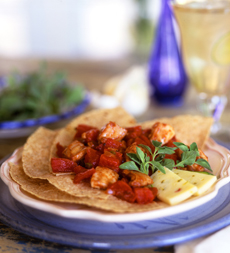
August 2008
Last Updated November 2025
|
 |
Types Of Bread, Including Artisan Bread
Page 9: Glossary Of Bread Types ~ T To Z
This is page 9 of a 9-page glossary of the many different types of bread. Click on the links below to visit other pages. You can also return to the overview and the history of bread or select from many more food glossaries.
Click on a letter to go to the appropriate glossary section:
a b c d e f g h i j k l m n o p q r s t u v w x y z
This glossary is protected by copyright and cannot be reproduced in whole or in part. You are welcome to link to it.
|
TEXAS TOAST
Texas toast is thick-sliced white bread about twice as thick as standard sandwich bread (usually around 3/4" to 1" thick). The thickness is really what sets it apart from regular toast, along with lots of butter. It’s traditionally generously buttered on both sides, then grilled or toasted until both sides are golden brown and crispy on the outside.
It’s commonly served as a side with barbecue, steak, fried chicken, or other hearty American dishes. It's also popular for making patty melts and other diner-style sandwiches, where you want a substantial type of bread that won’t get overwhelmed by the fillings.
A popular variation is garlic Texas toast, where garlic (fresh, powdered, or in butter form) is added along with the butter before toasting or grilling (second photo). In fact, it’s so popular that many people associate Texas toast with the garlic version.
The origins of the name are debated. Some say it originated at the Pig Stand restaurant chain in Texas in the 1940s, while others attribute it to different Texas establishments. Regardless, it's become a staple comfort food.
|
|
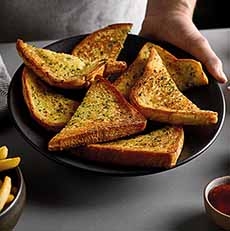
Texas toast (photo © St. Pierre Bakery).
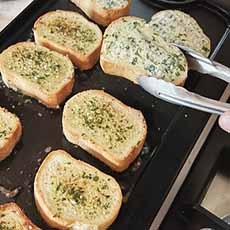
Garlic Texas toast. Here’s the recipe (photo © Taste Of Home). This version is made from a loaf of Italian bread. |
|
TIGER BREAD
The original name for Dutch Crunch bread, which originated in the Netherlands. In the U.K., you can also find it called giraffe bread. Here’s more about it.
TOAST
Toast typically refers to toasted bread sliced from a loaf. It is a popular breakfast bread, served with butter and jam. Many people also prefer their sandwich bread toasted; the firmer, toasted bread is a requirement for the stability of triple-decker sandwiches.
|
|
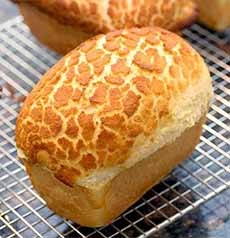
Tiger bread (photo © Honeyville). |
|
TORTILLA
A thin, unleavened flatbread, dating to prehistoric times. Originally made from finely ground maize (corn), it is made from wheat flour in regions of Mexico unsuitable for growing corn.
Called “tlaxcalli” by the native Nahuatl-speaking peoples (including the Aztecs), the bread was named “tortilla” by the Spanish Conquistadors because it resembled Spanish round unleavened cakes.
|
|
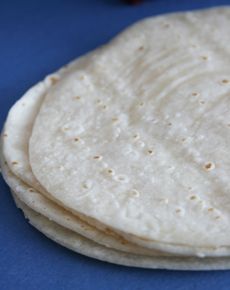
Tortillas. Photo by Hannah Kaminsky | THE NIBBLE. |
|
TSOUREKI
A sweet, egg-enriched bread formed of braided strands of dough, which is popular in the countries of the former Ottoman Empire. Tsoureki is the Greek name; it has different names in Arabic, Bulgarian, Romanian, Turkish, and other languages. The recipe includes milk, flour, eggs, sugar, yeast, butter, and a spice such as cardamom or mastic. The bread is soft and moist, yet chewy. Braided yeast breads are made for Christmas, Easter, and New Year’s; the Easter version often includes colored eggs.
VIENNA LOAF
An oblong loaf that is tapered at the ends.
|
|
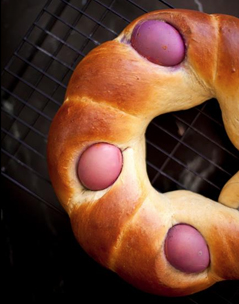
Tsoureki, Photo courtesy Artisan Bread In Five Minutes A Day. |
VIENNOISERIE
Viennoiserie are buttery, flaky breakfast bread and pastries made with laminated dough, a technique of layering and folding a yeast dough to create brioche, croissants, danish, pain au chocolate, and other so-called “Viennoiserie.” It is a marriage between traditional bread baking and sweet pastry baking. The technique of lamination produces many buttery layers that can be pulled apart to reveal thin leaves within. You can see the striations, or layers, of pastry when you look at the top of the Viennoiserie or when you cut into them. This technique is time-consuming and expensive (because of the amount of butter needed). According to legend (subsequently disproved), the croissant was created to commemorate the defeat of the Turks in Vienna; hence, the group of specialty breads became known as Viennoiserie. See croissant for the accurate history.
|
|
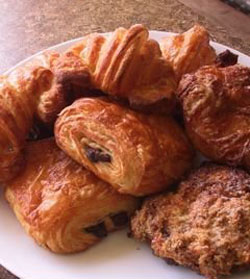
You can see the difference in the fluffy, flaky, buttery dough of the Viennoiserie (croissants at the top, pain au chocolat in the center, and the kouing aman at the far right top) and the non-Viennoiserie flat scone at the bottom right. Photo © copyright Les Madeleines.
|
WALNUT BREAD
Often made with whole-wheat flour, walnut bread (pain aux noix) is popularly served with a cheese course. Hazelnuts can be substituted.
WHITE BREAD
White bread is a modern invention made from refined, bleached wheat flour, designed to create a convenience product. Unfortunately, the bleaching, along with the removal of the bran and germ in the refining of white flour, removes most of the nutrients and fiber.
In the U.S., white flour must be enriched with folic acid, iron, niacin, riboflavin, and thiamin to compensate for the loss of these nutrients during the milling process. Effective January 1997, the addition of folic acid replaces most of the major vitamins removed by bleaching (“enriched flour”), although valuable trace minerals are not replaced in this process. Nutritionists advise substituting whole-grain breads for white.
The bread is typically a soft and pillowy rectangular loaf, pre-sliced, with a mild, slightly sweet flavor due to added sugar or other sweetener. Brands like Wonder Bread are the classic example.
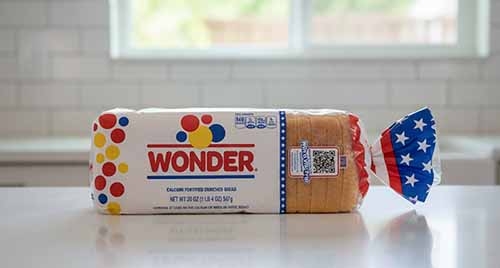
The Taggart Baking Company of Indianapolis, Indiana, trademarked Wonder Bread in 1921 (Taggart was acquired in 1924 by the Continental Baking Company—Abacus photo).
WHOLE WHEAT BREAD
Whole-wheat bread is made from whole-wheat flour. Unlike white flour, whole wheat has not been refined; the bran and germ of the wheat grain, which contain most of the nutrition and fiber, have been retained prior to milling. Bread made from whole-wheat flour is light brown in color. Until recent times, when the superior nutrition of this bread has been acknowledged, brown bread, which is cheaper to make than refined white bread, was considered aesthetically inferior and relegated to the poorer classes that could not afford white bread.
|
|
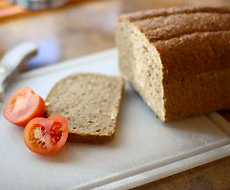 Whole wheat bread. Photo by Tommy Johansen | SXC. Whole wheat bread. Photo by Tommy Johansen | SXC. |
WHOLE GRAIN or WHOLEGRAIN
BREAD
A whole grain loaf can be made in any size and shape from one or more whole grains. Whole grains that are baked into bread include corn, flaxseed, hemp, oats, rye, spelt (farro), and whole wheat. For more information, including a full list of whole grains, read our article about whole-grain cereals.
Note that loaves described as “multigrain,” “7 grain,” etc., are not whole grain unless they so specify. Otherwise, they most likely contain a variety of refined grains that are not whole grains.
|
|
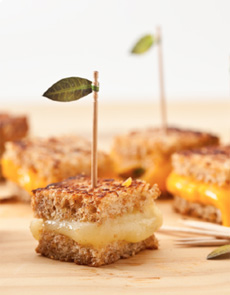 Grilled cheese sandwich bites on whole-grain bread. Photo courtesy Wholesome Junk Food Cookbook. \ Grilled cheese sandwich bites on whole-grain bread. Photo courtesy Wholesome Junk Food Cookbook. \ |
WRAP or ROLL-UP
Wrap is short for a wrap sandwich. Instead of a roll or two slices of bread, a flatbread, generally a tortilla, is used to make the sandwich. The sandwich is called a wrap or a roll-up because the filling is “rolled up” in the tortilla.
Wrap sandwiches became popular in the United States during the 1990s. It probably was created in California, inspired by the burrito. It may have been invented and named at a Southern California chain called I Love Juicy in the early 1980s.
The San Francisco-based chain World Wrapps, which opened its first location in February 1995, is credited with popularizing the wrap nationwide.
|
|
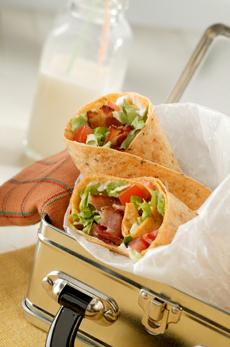
A BLT wrap (photo © National Pork Board). |
WILD YEAST
Artisan bread makers use wild yeasts instead of commercially produced yeasts, and wild yeast is required to make authentic sourdough. There are many varieties of wild yeast, each with its own flavor characteristics. Several different kinds can be found in a single starter. See yeast, below. The history of the use of wild yeast may predate the alphabet. Hieroglyphics that are 5,000 years old show Egyptians using yeast to leaven bread and ferment alcohol. Since they had no understanding of, or control over, the microorganisms, the process was a mystery.
Food scientists believe that these early yeast-based reactions were created by the natural microbial contaminants of flour and other milled grains, and from fruit or other juices containing sugar. Their microbial flora would have included wild yeasts and the lactic acid bacteria that are found associated with cultivated grains and fruits. With bread, a small portion of starter dough was retained and used to start (leaven) each new bread dough
(source).
YEAST
Yeast is a natural leavening agent; the first leavened breads were made by setting out the dough to be attacked by wild yeast. The ancient Egyptians were already using wild yeast strains to raise their bread.
Over millennia, yeast starters were maintained. It was not until the invention of the microscope, followed by the pioneering work of Louis Pasteur in the late 1860s, that yeast was identified as a living organism and the agent responsible for alcoholic fermentation and dough leavening.
Shortly following these discoveries, it became possible to isolate yeast strains in a pure culture form. Commercial production of baker’s yeast began around the turn of the 20th century.
Since then, it has been discovered that different strains of yeast are better in different situations. The commercial yeast used for leavening bread today is Saccharomyces cerevisiae (also used for brewing beer, whiskey, and other alcoholic beverages). Commercial yeast is made from a pure culture to produce uniform results.
In 1876, brothers Charles and Max Fleischmann of Cincinnati (née Austria) introduced their new commercial yeast to the public, revolutionizing the bread-baking business. It was a compressed cake of yeast requiring refrigeration. But it didn’t stop there:
-
When America entered World War II, Fleischmann developed Active Dry Yeast, specifically to ensure GIs could enjoy home-baked bread. It did not require refrigeration and was activated quickly with warm water.
|
|
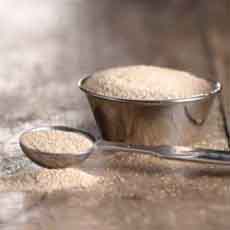
Fleischmann’s instant yeast is granulated and easy to work with (photo © King Arthur Flour).
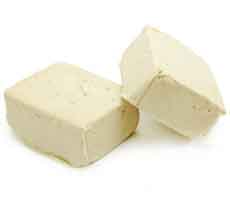
Originally, commercial yeast was sold in cubes, needed to be refrigerated, and was much more cumbersome to work with than modern dried yeast (photo © Pantryparatus). |
-
In 1984, Fleischmann’s launched RapidRise Yeast. This highly active, finer-grain of dry yeast raises dough as much as 50% faster than regular active dry yeast.
-
In 1993, Fleischmann’s introduced bread machine yeast, specially formulated to produce excellent-tasting loaves in any kind of bread machine. Who said yeast wasn’t an exciting product?
Yeast ferments the carbohydrates in the flour (or the grain in the alcohol), producing carbon dioxide. Many artisan bakers produce their own yeast by keeping a starter culture, which can last for years—following in the footsteps of bakers thousands of years ago [source]. See also wild yeast.
|
YEAST BREAD
A bread that is leavened by the fermentation of sugar by yeast. Many breads are yeast breads, from some white and whole wheat breads to challah to sourdough.
Go To The Glossary Index Above
|
|
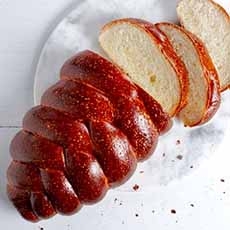
Challah is a yeast bread (photo © Honeyville). |

|




